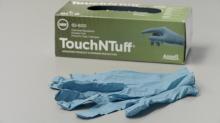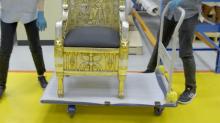Handling Objects
What you will need:


Transcript
Getting started
In this video I am going to talk to you about how to safely handle objects in your collection.
Poor handling techniques causes far more damage to museum objects than any other factor. For this reason it is important that handling is kept to a minimum, and that everyone is aware of correct handling procedures.
Wearing gloves
Firstly the oil from your skin contains acids and salts that can create permanent staining. This damage may not be apparent right away. It is therefore really important to wear gloves when handling objects.
White cotton gloves are commonly used as they can be washed and reused. It is a good idea to have a special container for used gloves so that they are kept separate from clean gloves.
I prefer to use nitrile gloves for object handling. Use powder free gloves to avoid transferring powder to your collection and make sure that they fit well so that you can feel the objects that you are touching.
This option works particularly well for:
- Slippery items such as a large vase.
- Friable items such as bark paintings.
- Rough surfaces such as corroded iron or splintered wood.
- Delicate items such as paper or textiles.
Safety considerations
While wearing gloves protects the objects you handle, it is also important to be aware of safety issues when handling museum objects:
Always ask for assistance when moving a heavy or large item as this is safest both for your back and for the object. If possible, use trolleys or dollies to help safely move heavy items as the last thing you want to do is drop them.
Some museum objects can also be toxic or dangerous. This includes:
- Items affected with mould.
- Items made from lead or radioactive material.
- Live ammunition.
- Leaking wet specimens.
- Containers filled with old medicines or pesticides.
- Natural history specimens as older items were often treated with toxic preservatives such as arsenic. These items may require additional protective equipment or specific advice.
Movement planning
Particularly for large objects, know your route and plan before you move.
Do you need any additional assistance? and you may need someone to walk with you to open doors or spot. Does the object have any weak points? Are there any detachable components that should be removed or secured? Is a support trolley, or box required?
Asking these questions can make the difference between safe transport and a broken object.
It is good practice to prepare a place for the object to go before moving it. Remember to remove or cover any jewellery, buckles, watches, lanyards or pens that may cause damage to the object.
Moving objects
It may seem like common knowledge but take care not to knock others over when removing shelved items. It may be necessary to remove some objects in order to safely access the one you want to move.
Always use both hands when lifting the object. Depending on the size and shape, you can often use one hand to support the object from below while using the other to steady it. Always handle objects by the strongest point. Do not rely on handles or other attachments, as these features may no longer be properly affixed. Also try to move only one object at a time unless they are all secured in a box or a trolley.
When you are packing or moving objects, supports should always be used for fragile items that cannot support their own weight.
If you are placing items in a box or a support, consider the safest orientation to prevent the item from toppling or rolling. You may need to use cushions or foam blocks to prevent movement or to separate multiple items.
Always move slowly and carefully when carrying objects.
When working with others, verbally discuss your actions before and during the move.
Large objects
Large items such as furniture should always be lifted, never pushed or dragged directly on the floor. Make sure to secure or remove any loose components such as drawers before lifting. Never pick up chairs by the armrests or backs. When using a trolley to move large furniture or large items, they should generally be placed in their normal orientation, and not rested on their sides or corners which can cause damage to the joints.
Paper objects
Documents and works on paper should be lifted carefully and then placed on a support or in a folder to move them.
Paintings
For paintings it is safest to move them vertically. Use two hands, one at the bottom and one at the side. Do not hold the work from the top of the frame or by its decorative elements. Avoid touching the back of the canvas as this can cause serious damage to the painting. If the reverse of the painting has secure handling straps these can also be used.
If you are handling a small painting by yourself face the painting towards you. For larger works that require two people to carry it, the work should face outwards.
If placing a painting on the floor, place pads or blocks underneath it. They should be high enough to prevent any decorative elements from touching the floor. A piece of polyethylene foam or a piece of card to separate the work from the wall can be handy.
If you are required to stack several paintings, they should be placed face-to-face, back-to-back.
At the end of the day making sure you handle your collection correctly will help you keep your collection well organised and limit the chance of your items accidentally getting damaged. Especially when handling or accessioning fragile items it pays to be confident in your abilities, something that can help steady shaky hands.
Thanks for listening.












